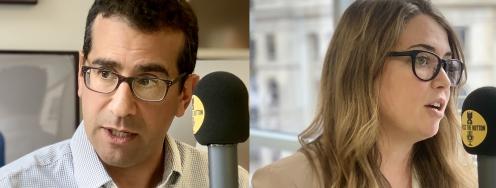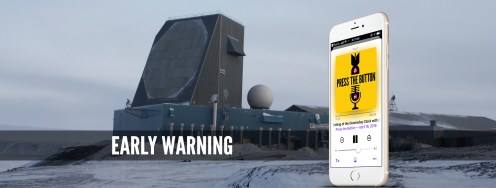Inside the Mission to Secure Plutonium Mountain
On the radar: “The world has become safer”; The complexities of lifting sanctions; Redoing the cabinet; Nuclear terrorism risk; and Another missile wing botches inspections.
On the radar: “The world has become safer”; The complexities of lifting sanctions; Redoing the cabinet; Nuclear terrorism risk; and Another missile wing botches inspections.
August 20, 2013 | Edited by Benjamin Loehrke and Alyssa Demus
The 17-year mission - After the Soviet Union collapsed, Russia abandoned its nuclear test site in Kazakhstan - leaving in place a network of tunnels containing plutonium that could have been recovered and recycled into nuclear weapons. These tunnels were open to scavengers looking for metal or other actors intent on building a bomb. David Hoffman and Eben Harrell offer a history of the race to seal the tunnels and secure the materials.
--“Securing the plutonium in Kazakhstan proved to be a laborious undertaking spanning 17 years, an effort requiring scientists willing to work together across countries and time zones, united only by a determination to get results. Such hidden repositories might be found elsewhere, wherever nations have tested nuclear weapons or carried out other research on fissile materials such as plutonium. Will all that scientific collaboration and goodwill be readily available? It is true, as the plaque at Degelen Mountain attests, that the world is safer thanks to this operation. But it is also true that the scars left by nuclear weapons testing during the Cold War will last for millennia.” Full story in The Washington Post. http://wapo.st/14yk7F6
--Full report: “Plutonium Mountain: Inside the 17-year Mission to Secure a Danverous Legacy of Soviet Nuclear Testing” by Eben Harrell and David Hoffman for the Belfer Center’s Project on Managing the Atom. (pdf) http://hvrd.me/180oc68
Welcome to Early Warning - Subscribe to our morning email or follow us on twitter.
--Have a tip or feedback for the editor? Email earlywarning@ploughshares.org earlywarning@ploughshares.org. Want to support this work? Click here.
Looking back - “I was alarmed to find unmanned guard posts and virtually no security at the site. My Los Alamos colleagues and I became convinced that Semipalatinsk was not only a serious proliferation problem, but also an urgent one. The copper cable thieves were not nomads on camelback, but instead they employed industrial excavation machinery and left kilometers of deep trenches digging out everything they could sell. We were concerned that some of that copper cabling could lead to plutonium residues,” said Sig Hecker on his experience visiting the abandoned Soviet nuclear test site at Semipalatinsk. Q&A from Stanford’s CISAC. http://stanford.io/180soD1
Dealing with sanctions - Iran’s new president is signalling an opportunity for a negotiated settlement to limit Iran’s nuclear program, likely done in exchange for sanctions relief. Yet, given the complexity of the US sanctions regime, it is unclear how much latitude the Obama administration has to suspend or terminate sanctions as part of a nuclear deal.
--Sanctions expert Ken Katzman goes through the US sanctions in force against Iran and explains the array of waivers, certifications and other mechanisms available to the president to use sanctions relief as a means secure a deal that keeps Iran from the bomb. Full analysis at Al Monitor. http://bit.ly/14Tbnss
Cabinet changes - Iran’s new president Hassan Rouhani has appointed outgoing Foreign Minister Ali Akbar Salehi to head the Atomic Energy Organization of Iran (AEOI). The agency is “not directly involved in nuclear negotiations with world powers, but is in charge of operating Iran’s nuclear facilities. Salehi who is seen as a pragmatist will replace hardliner Fereydoun Abbasi-Davani. Reuters has the full story. http://ow.ly/o5SW3
Tweet - @Reuters: Iran's president still undecided on his nuclear negotiator http://reut.rs/16Ga8Uc
Conversions - Iran is continuing to limit its 20% enriched uranium stockpile - one of the most troubling features of Iran’s program - by converting more of the uranium into reactor fuel. The forthcoming IAEA report on Iran - due around August 27-28 - will discuss Iran’s conversion activities in more detail. http://ow.ly/o5UuX
Exposing vulnerabilities - A new study finds that every commercial nuclear reactor is “insufficiently protected against ‘credible’ terrorist threats,” like the theft of fissile materials and attacks designed to cause meltdowns. "America's civilian nuclear facilities remain unprotected against a terrorist attack [on the] scale,” of September 11. “Instead, our civilian reactors prepare only against a much smaller-scale attack,” said report co-author Alan J. Kuperman. Full story by Brian Montopoli at CBS News . http://ow.ly/o5YoG
Bungling the bomb - The 341st missile wing in charge of a third of the country’s nuclear-tipped ICBMs have become the latest wing to fail its readiness inspection. “I have every confidence if it were a real-world situation, it would have been flawless,” said Col. Rob Stanley commander of the 341st missile wing of a recent surety inspection his wing failed. “Still, the inspection failure and other incidents have created an image problem for the Air Force, said Hans Kristensen of the Federation of American Scientists.”
--“How can you build public trust with an inspection system where nuclear units continue to fail? The leadership should not connote a mindset that failing an inspection is a good thing because it reveals things that should be fixed. Units with responsibility for nuclear weapons should not fail inspections. Period,” said Kristensen. Full story at the Air Force Times. http://ow.ly/o64w6
Tweet - @Cirincione: CIA finally admits what everyone in Iran knows, and few in America do: It Was Behind Iran's Coup http://bit.ly/17HbPx7
Speed reads -
--“Hassan Rouhani and Iran’s nuclear opportunity” by Jonathan Marcus at BBC News. http://ow.ly/o62ld
Events:
-- “Extended Deterrence and Strategic Stability in Northeast Asia,” Brad Roberts. August 26, 9:00 AM @ Stimson Center. Details here. http://ow.ly/o3wNq
--”The Path to Zero: The role of the United Nations in Nuclear Disarmament and Non-Proliferation.” September 5, 10:00 AM. Webcast here. http://webtv.un.org/
--President Obama attends the G-20 summit in St. Petersburg. September 5-6.


